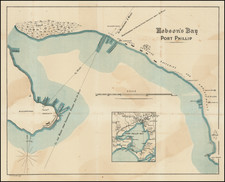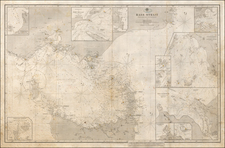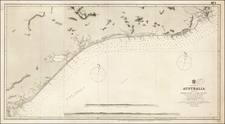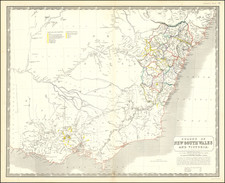First state of John Arrowsmith's map of Western Australia.
The map shows the Colony of Western Australia, along inset maps of Perth, Guildford, Freemantle, Augusta and Kelmscott.
The map was printed from 1839 until 1863 in eight states, tracking the growth of the colony over the course of 24 years.
John Septimus Roe (1797–1878) was the first Surveyor-General of Western Australia. He was a renowned explorer, and a Member of Western Australia's legislative and executive councils for nearly 40 years. In 1829, he too the position of Surveyor-General of Western Australia, to be attached to an intended new settlement at the Swan River. Roe accepted on the condition that the position be a civilian appointment, as he was keen to leave the navy. Over the course of the next several decades, he conducted a thorough survey of the region, including
- In June 1829, he explored the Swan and Canning River;
- In January 1830, he explored the country around Leschenault, the Collie, Ferguson and Preston Rivers, Cape Naturaliste and Geographe Bay;
- In November 1831, he explored the area around Albany, Doubtful Island Bay, Torbay, Wilsons Inlet, the Kalgan River and Kojonup;
- In 1832 he explored around the Hotham and Williams Rivers;
- In 1834, he explored to Pinjarra on the Murray River, then Bunbury, Kojonup, Albany and back to Perth; the Battle of Pinjarra occurred during this expedition;
- In 1835, he explored the area around Moorilup on the Kalgan River, then explored the Hay and Sleeman Rivers.
- In October and November 1835, he was part of the Great Southern Expedition, which explored the country between Perth and Albany by two different routes, with a view to deciding on a route for a road between the two towns;
- In October and November the following year, he explored the land 180 miles east and 100 miles north from Perth
- In December 1837 he discovered and surveyed Peel Harbour and Warnbro Sound.
- In January 1838 he explored the coast between the Swan River and Cape Naturaliste; In June 1838 he explored from the Swan River to Bunbury via the Murray, Harvey, Collie and Preston Rivers, then returned along the base of the Roe and Darling Ranges;
- In May 1839 he passed through unexplored country on an expedition to rescue from starvation three men who had been part of George Grey's disastrous expedition to Shark Bay;
- In December 1839, he travelled overland with Governor Hutt to Albany and back, using new routes;
- In June 1847, he explored the country around and north of Champion Bay.
- From September 1848, he conducted a five-month-long expedition "from Avon River to Stirling Range, and thence eastward to Russell Range and Cape Pasley on the south coast, and 60 to 100 miles inland, returning by different routes on this occasion discovered coal on the Rivers Fitzgerald and Phillips."2 Roe was seriously injured on this expedition, and undertook no additional ones.
The present map is the scarce first state of Arrowsmith's map.
The Arrowsmiths were a cartographic dynasty which operated from the late-eighteenth century to the mid-nineteenth. The family business was founded by Aaron Arrowsmith (1750-1823), who was renowned for carefully prepared and meticulously updated maps, globes, and charts. He created many maps that covered multiple sheets and which were massive in total size. His spare yet exacting style was recognized around the world and mapmakers from other countries, especially the young country of the United States, sought his maps and charts as exemplars for their own work.
Aaron Arrowsmith was born in County Durham in 1750. He came to London for work around 1770, where he found employment as a surveyor for the city’s mapmakers. By 1790, he had set up his own shop which specialized in general charts. Arrowsmith had five premises in his career, most of which were located on or near Soho Square, a neighborhood the led him to rub shoulders with the likes of Joseph Banks, the naturalist, and Matthew Flinders, the hydrographer.
Through his business ties and employment at the Hydrographic Office, Arrowsmith made other important relationships with Alexander Dalrymple, the Hudson’s Bay Company, and others entities. In 1810 he became Hydrographer to the Prince of Wales and, in 1820, Hydrographer to the King.
Aaron Arrowsmith died in 1823, whereby the business and title of Hydrographer to the King passed to his sons, Aaron and Samuel, and, later, his nephew, John. Aaron Jr. (1802-1854) was a founder member of the Royal Geographical Society (RGS) and left the family business in 1832; instead, he enrolled at Oxford to study to become a minister. Samuel (1805-1839) joined Aaron as a partner in the business and they traded together until Aaron left for the ministry. Samuel died at age 34 in 1839; his brother presided over his funeral. The remaining stock and copper plates were bought at auction by John Arrowsmith, their cousin.
John (1790-1873) operated his own independent business after his uncle, Aaron Arrowsmith Sr., died. After 1839, John moved into the Soho premises of his uncle and cousins. John enjoyed considerable recognition in the geography and exploration community. Like Aaron Jr., John was a founder member of the RGS and would serve as its unofficial cartographer for 43 years. Several geographical features in Australia and Canada are named after him. He carried the title Hydrographer to Queen Victoria. He died in 1873 and the majority of his stock was eventually bought by Edward Stanford, who co-founded Stanford’s map shop, which is still open in Covent Garden, London today.












![[ Tasmania / Hunter Island ] Carte des Iles Hunter dressee Par L. Freycinet, Commandant la Goelette le Casuarina, d'apres ses observations et celles de Mr. Boullanger Ingenieur Hydrographe -- December 1802. (Rare separately published example)](https://storage.googleapis.com/raremaps/img/small/53891.jpg)

